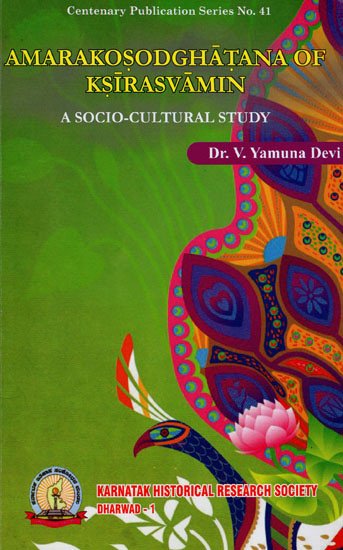Amarakoshodghatana of Kshirasvamin (study)
by A. Yamuna Devi | 2012 | 77,297 words | ISBN-13: 9788193658048
This essay studies the Amarakoshodghatana of Kshirasvamin (in English) which represents a commentary on the Amarakosha of Amarasimha. These ancient texts belong the Kosha or “lexicography” category of Sanskrit literature which deals with the analysis and meaning of technical words from a variety of subjects, such as cosmology, anatomy, medicine, hy...
Preface
Lexicography or Koṣa writings naturally precede the regular analysis of language as it largely helps in understanding the meaning of a word. It sometimes gives the metaphorical sense sanctioned by the usage, but the primarily significative power is not to be assumed in such cases.
The domain of Koṣa literature is also of varied types. Many well known Koṣas as Amarakośa, Abhidhānaratnamālā and Vaijayantīkoṣa deal with synonyms and homonyms of profession, occupation, cosmology, flora, fauna, human body and so on. Koṣas like Dhanvantari Nighaṇṭu, Śivakoṣa and Aṣṭāṅga Nighaṇṭu, have for their domain synonyms of plants and herbs, vegetables and mineral substances and their medicinal properties. Approved recipes, diseases, diet, hygiene etc. are treated in Hṛdayadīpikā, Śataślokī, Kalpadrukoṣa, etc. Rājavyavahārakoṣa deals with technical terms of administration and related topics. Dvirūpakoṣa of Śrīharṣa deals with two forms of words slightly different from each other. Deśīnāmamālā of Hemacandra and the like give the Prākṛt words with Sanskrit equivalents. Anekārthakoṣa of Śāśvata, Ekākṣarakoṣa, Viśvaprakāśa and others deal exclusively with homonyms.
Sanskrit lexicons are composed in verses to serve the purpose of memorising. Majority of lexicons deal with either synonyms or homonyms while some deal with both. The words are arranged subject-wise, with further sub-divisions based on grouping of words of one, two, three and more syllables or by the first or the final syllable.
The commentaries help in understanding the meaning of words either by giving their synonyms or by describing their meanings. Patañjali in his Paśpaśāḥnika highlights the role played by the commentator in deciding the meaning of a word, solely based on the commentary.
The lexicographical literature and commentaries on them form a large portion of Sanskrit literature. They have acquired a position of great significance in the history of Sanskrit literature. Still, not much study has been done on this section of literature. Though there are many articles by great scholars on the nature of lexicons, their specialities, their unique contribution to the development of Sanskrit and so on, only a few studies are available on lexicons as a separate genre of literature, like–Indian Lexicography by Vogel Claus (pub. by Otto Harrassowitz, Wiesbaden, 1979); History of Sanskrit Lexicography by Patkar, Madhukar. M (Munshiram Manoharlal publishers, New Delhi,1981); Saṃskṛta koṣa vāṅmaye sāmānyaparicayaḥ by Keshava Sharma, (Saṃskrt Shodh Saṃsthan, Shimla, H.P, 1976). A thesis titled Abhidhānaratnamālā–A cultural study was presented to the Pondicherry University, in Sept. 2000 by Dr. L. Sampath Kumar.
Amarakośa of Amarasiṃha is the earliest lexicon available belonging to the 6th century A.D. followed by the other lexicons mentioned above. Amarakośa is called Nāmaliṅgānuśāsanaṃ by the author himself because, along with the synonyms, the genders are also denoted by certain techniques mentioned at the beginning of the work. The Amarakośa itself was a compilation of earlier lexicons as stated by the author. He further declares that the words arranged wrongly in the earlier lexicons were rearranged by him according to certain principles; also the multitudinous classes unnecessarily sectioned in the earlier lexicons were shortened by him.
The popularity of Amarakośa is evident from the fact that it has more than eighty commentaries, of which only about fifteen are published and the rest are found in manuscripts. But there has not been much study done on Amarakośa or its commentaries despite the fact that the editions of Amarakośa by Borooah (with com. of Xirasvāmin and Mukuṭa, Berhampore, London, 1887), Kṣīrasvāmin G. Oka (with Amarakośodghāṭana, Bharat Bharati Bhandar, Delhi, 1993), Dr. Hardutt Sharma and Dr. N. G. Sardesai (with Amarakośodghāṭana, Oriental Book Agency, Poona 1941) and A. A. Ramanathan (with unpublished south Indian Commentaries Amarapadavivṛti of Liṅgayyasūrin and Amarapārijāta of Mallinātha, The Adyar library and Research Centre, Madras, 1971) carry introductions of great academic value. The Amarakośasya vātāyanāt, by Dr. Rama Dubalish (Vidhyanidhi Prakashan, Delhi, 2003) and Nāmaliṅgānuśāsane pāṇinīyaprabhāvaḥ by Prof. Janamaddi Ramakrishna (Rashtriya Saṃskrit Vidya Peeth, Tirupati, 2005) are major studies done on Amarakośa.
While studies on Amarakośa itself are quite few, only much less can be stated about its commentaries. Except the study on the commentary of Jātarūpa by Dr. Mahesh Raj Pant (MLBD, Delhi, 2000), no other study on commentaries on Amarakośa has been done in detail. It is to be noted that the Jātarūpa's commentary is available only in fragments. Hence Kṣīrasvāmin's commentary viz. Amarakośodghāṭana is taken up here for study. Accordingly, the thesis is divided into seven chapters–A brief survey of Koṣa literature; Author’s life, date and works; Social Aspects; Cultural Aspects; Aspects of Nature; Grammatical Aspects and Evaluation.
